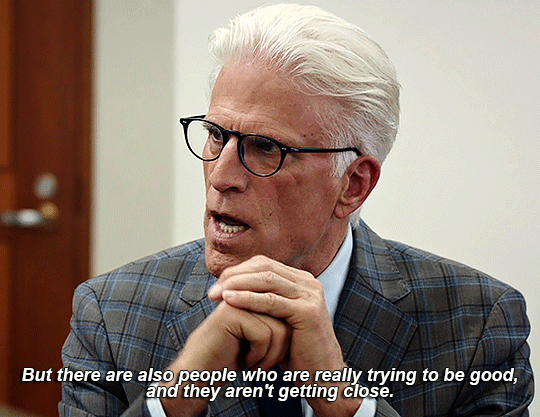Don't wanna be here? Send us removal request.
Text
Let me try this
So let the wheel decide your Japanese first-person pronoun
Note: descriptions may be inaccurate.
14K notes
·
View notes
Photo






The psychiatrist who wrote the criteria for narcissism just made an extremely important point about what’s wrong with diagnosing Trump with mental disorders
Dr. Allen Frances says in speculating about Trump’s mental health, we are doing a disservice to those who do suffer from mental illness. In a series of tweets, he explained why he doesn’t think Trump is a narcissist — and how harmful it can be for us to keep assuming that he is.
#donald trump#he ain't crazy bc he's doing all this shit on purpose#calling him crazy absolves him of his very deliberate attempts to seize power wnd undemind our democracy and freedoms
124K notes
·
View notes
Text
With the ides of march fast approaching we must be prepared
Please reblog to make sure everyone is equipped!
41K notes
·
View notes
Text
One of the common mistakes I see for people relying on "AI" (LLMs and image generators) is that they think the AI they're interacting with is capable of thought and reason. It's not. This is why using AI to write essays or answer questions is a really bad idea because it's not doing so in any meaningful or thoughtful way. All it's doing is producing the statistically most likely expected output to the input.
This is why you can ask ChatGPT "is mayonnaise a palindrome?" and it will respond "No it's not." but then you ask "Are you sure? I think it is" and it will respond "Actually it is! Mayonnaise is spelled the same backward as it is forward"
All it's doing is trying to sound like it's providing a correct answer. It doesn't actually know what a palindrome is even if it has a function capable of checking for palindromes (it doesn't). It's not "Artificial Intelligence" by any meaning of the term, it's just called AI because that's a discipline of programming. It doesn't inherently mean it has intelligence.
So if you use an AI and expect it to make something that's been made with careful thought or consideration, you're gonna get fucked over. It's not even a quality issue. It just can't consistently produce things of value because there's no understanding there. It doesn't "know" because it can't "know".
#AI#'AI' cant think so letting it think for you doesn't work#also it means YOU aren't thinking and thats a HUGE problem#your brain NEEDS stimulation#it needs to problem solve#please don't let 'AI' do everything for you
36K notes
·
View notes
Text

It's my 13 year anniversary on Tumblr 🥳
Can't believe I've been stuck on this hellsite long enough to become a hellsite teenager. (I love it. 😘)
0 notes
Text
Discord has added generative AI features to servers.
Here are THREE THINGS you need to do today.
1️⃣ YOUR SERVER
Go into server settings -> roles -> Default permissions
Search for "external apps" and disable it

2️⃣ YOUR FEEDBACK
Access Discord support -> https://support.discord.com/hc/en-us/requests/new
Go into Help & Support > Feedback/New Feature Request
Denounce generative AI and request the feature be removed. Bring up privacy concerns for yourself, your data, and for minors.
You will get an automatic reply to this request- PLEASE REPLY TO THE EMAIL TO PUSH IT TO THE TEAM or else it will get discarded.
3️⃣ ON MOBILE
Access your app store
Leave a 1 star review and publicly denounce generative AI and Discord's use of it
Reblog this to spread the word, I'm tired of the enshittification of the things I use in my day to day life.
19K notes
·
View notes
Text

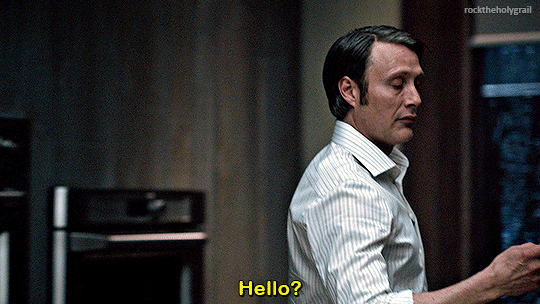
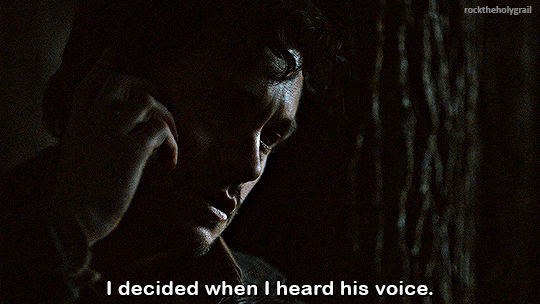



Hannibal (2013-2015)
2x13 || 3x04
20K notes
·
View notes
Text

SO HERE IS THE WHOLE STORY (SO FAR).
I am on my knees begging you to reblog this post and to stop reblogging the original ones I sent out yesterday. This is the complete account with all the most recent info; the other one is just sending people down senselessly panicked avenues that no longer lead anywhere.
IN SHORT
Cliff Weitzman, CEO of Speechify and (aspiring?) voice actor, used AI to scrape thousands of popular, finished works off AO3 to list them on his own for-profit website and in his attached app. He did this without getting any kind of permission from the authors of said work or informing AO3. Obviously.
When fandom at large was made aware of his theft and started pushing back, Weitzman issued a non-apology on the original social media posts—using
his dyslexia;
his intent to implement a tip-system for the plagiarized authors; and
a sudden willingness to take down the work of every author who saw my original social media posts and emailed him individually with a ‘valid’ claim,
as reasons we should allow him to continue monetizing fanwork for his own financial gain.
When we less-than-kindly refused, he took down his ‘apologies’ as well as his website (allegedly—it’s possible that our complaints to his web host, the deluge of emails he received or the unanticipated traffic brought it down, since there wasn’t any sort of official statement made about it), and when it came back up several hours later, all of the work formerly listed in the fan fiction category was no longer listed.
THE TAKEAWAYS
1. Cliff Weitzman (aka Ofek Weitzman) is a scumbag with no qualms about taking fanwork without permission, feeding it to AI and monetizing it for his own financial gain;
2. Fandom can really get things done when it wants to, and
3. Our fanworks appear to be hidden, but they’re NOT DELETED from Weitzman’s servers, and independently published, original works are still listed without the authors' permission. We need to hold this man responsible for his theft, keep an eye on both his current and future endeavors, and take action immediately when he crosses the line again.
THE TIMELINE, THE DETAILS, THE SCREENSHOTS (behind the cut)
Sunday night, December 22nd 2024, I noticed an influx in visitors to my fic You & Me & Holiday Wine. When I searched the title online, hoping to find out where they came from, a new listing popped up (third one down, no less):

This listing is still up today, by the way, though now when you follow the link to word-stream, it just brings you to the main site. (Also, to be clear, this was not the cause for the influx of traffic to my fic; word-stream did not link back to the original work anywhere.)
I followed the link to word-stream, where to my horror Y&M&HW was listed in its entirety—though, beyond the first half of the first chapter, behind a paywall—along with a link promising to take me—through an app downloadable on the Apple Store—to an AI-narrated audiobook version. When I searched word-stream itself for my ao3 handle I found both of my multi-chapter fics were listed this way:

Because the tags on my fics (which included genres* and characters, but never the original IPs**) weren’t working, I put ‘Kara Danvers’ into the search bar and discovered that many more supercorp fics (Supergirl TV fandom, Kara Danvers/Lena Luthor pairing) were listed.
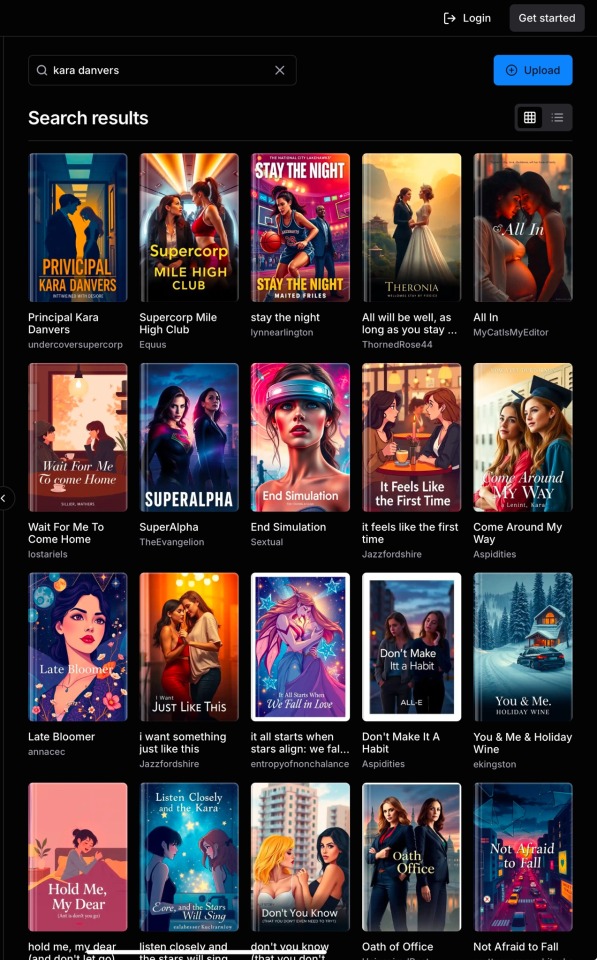
I went looking online for any mention of word-stream and AI plagiarism (the covers—as well as the ridiculously inflated number of reviews and ratings—made it immediately obvious that AI fuckery was involved), but found almost nothing: only one single Reddit post had been made, and it received (at that time) only a handful of upvotes and no advice.
I decided to make a tumblr post to bring the supercorp fandom up to speed about the theft. I draw as well as write for fandom and I’ve only ever had to deal with art theft—which has a clear set of steps to take depending on where said art was reposted—and I was at a loss regarding where to start in this situation.
After my post went up I remembered Project Copy Knight, which is worth commending for the work they’ve done to get fic stolen from AO3 taken down from monetized AI 'audiobook’ YouTube accounts. I reached out to @echoekhi, asking if they’d heard of this site and whether they could advise me on how to get our works taken down.

While waiting for a reply I looked into Copy Knight’s methods and decided to contact OTW’s legal department:
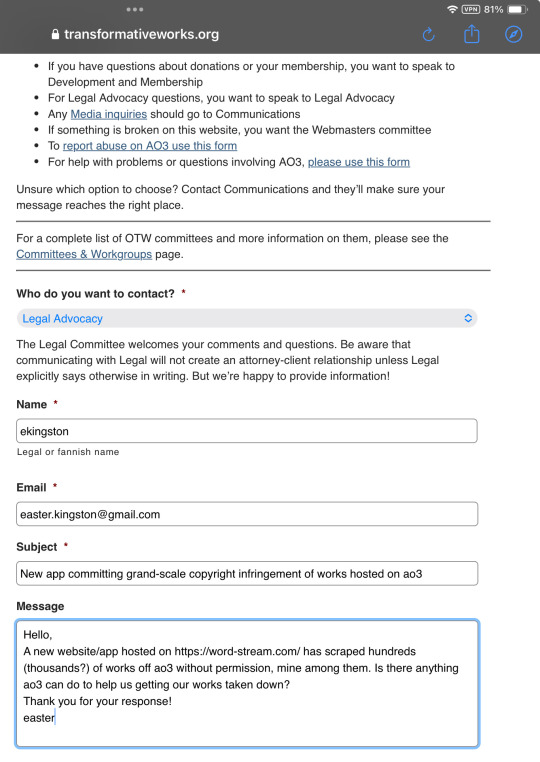
And then I went to bed.
By morning, tumblr friends @makicarn and @fazedlight as well as a very helpful tumblr anon had seen my post and done some very productive sleuthing:
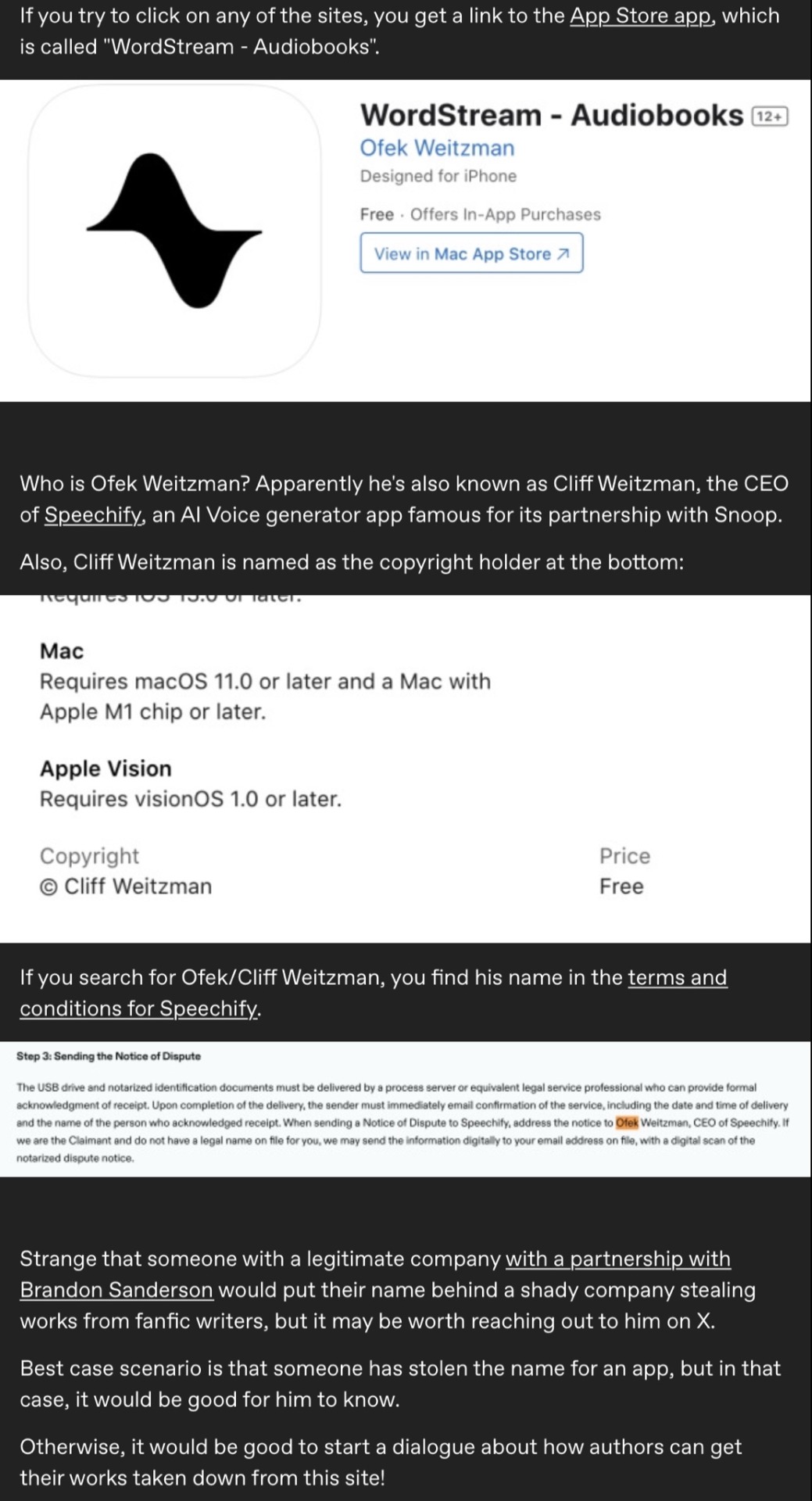
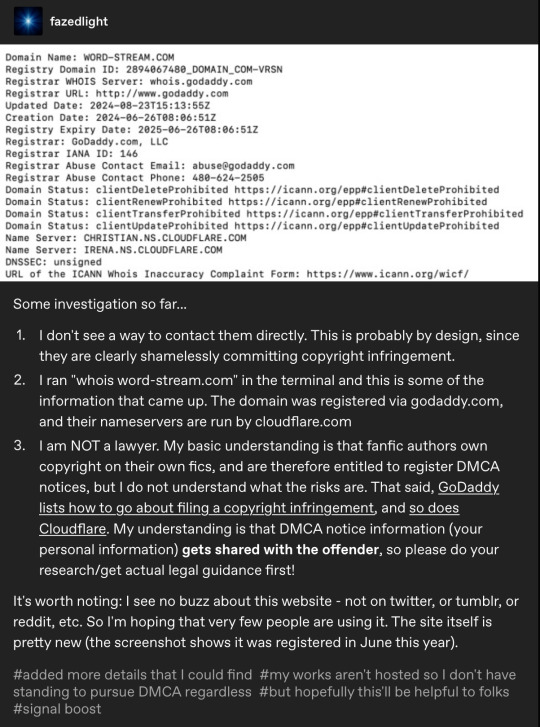
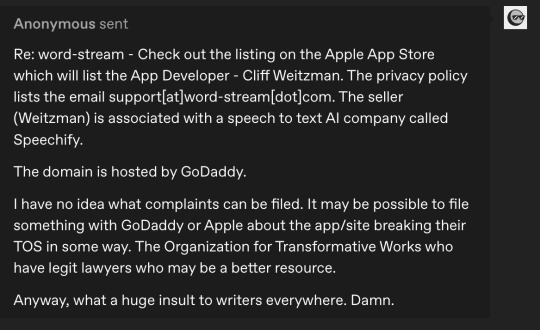
@echoekhi had also gotten back to me, advising me, as expected, to contact the OTW. So I decided to sit tight until I got a response from them.
That response came only an hour or so later:
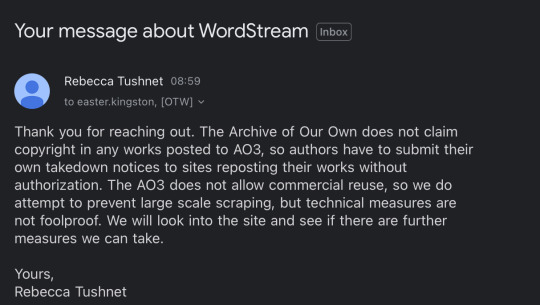
Which was 100% understandable, but still disappointing—I doubted a handful of individual takedown requests would accomplish much, and I wasn’t eager to share my given name and personal information with Cliff Weitzman himself, which is unavoidable if you want to file a DMCA.
I decided to take it to Reddit, hoping it would gain traction in the wider fanfic community, considering so many fandoms were affected. My Reddit posts (with the updates at the bottom as they were emerging) can be found here and here.
A helpful Reddit user posted a guide on how users could go about filing a DMCA against word-stream here (to wobbly-at-best results)
A different helpful Reddit user signed up to access insight into word-streams pricing. Comment is here.

Smells unbelievably scammy, right? In addition to those audacious prices—though in all fairness any amount of money would be audacious considering every work listed is accessible elsewhere for free—my dyscalculia is screaming silently at the sight of that completely unnecessary amount of intentionally obscured numbers.
Speaking of which! As soon as the post on r/AO3—and, as a result, my original tumblr post—began taking off properly, sometime around 1 pm, jumpscare! A notification that a tumblr account named @cliffweitzman had commented on my post, and I got a bit mad about the gist of his message :
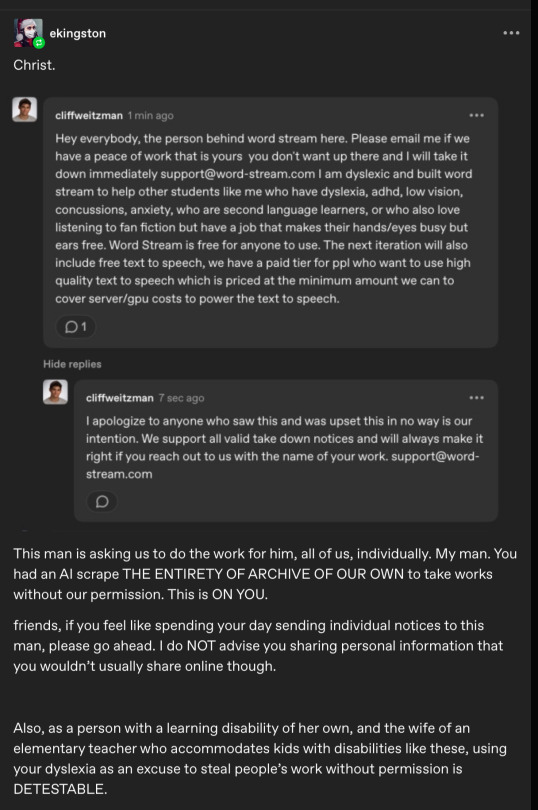
Fortunately he caught plenty of flack in the comments from other users (truly you should check out the comment section, it is extremely gratifying and people are making tremendously good points), in response to which, of course, he first tried to both reiterate and renegotiate his point in a second, longer comment (which I didn’t screenshot in time so I’m sorry for the crappy notification email formatting):
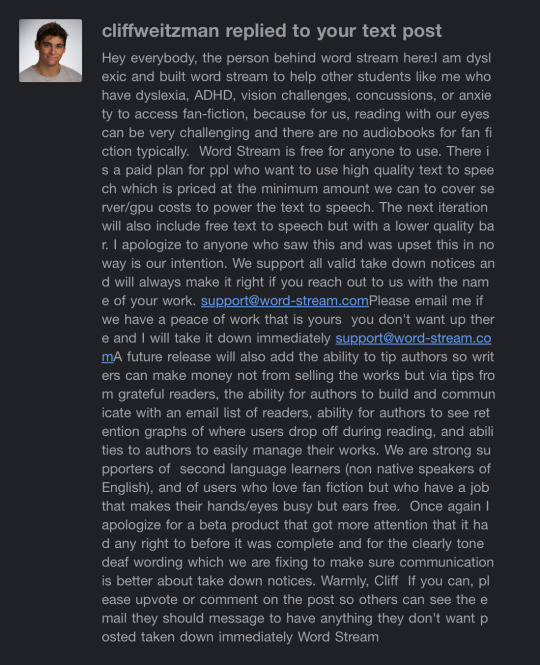
which he then proceeded to also post to Reddit (this is another Reddit user’s screenshot, I didn’t see it at all, the notifications were moving too fast for me to follow by then)

... where he got a roughly equal amount of righteously furious replies. (Check downthread, they're still there, all the way at the bottom.)
After which Cliff went ahead & deleted his messages altogether.
It’s not entirely clear whether his account was suspended by Reddit soon after or whether he deleted it himself, but considering his tumblr account is still intact, I assume it’s the former. He made a handful of sock puppet accounts to play around with for a while, both on Reddit and Tumblr, only one of which I have a screenshot of, but since they all say roughly the same thing, you’re not missing much:

And then word-stream started throwing a DNS error.
That lasted for a good number of hours, which was unfortunately right around the time that a lot of authors first heard about the situation and started asking me individually how to find out whether their work was stolen too. I do not have that information and I am unclear on the perimeters Weitzman set for his AI scraper, so this is all conjecture: it LOOKS like the fics that were lifted had three things in common:
They were completed works;
They had over several thousand kudos on AO3; and
They were written by authors who had actively posted or updated work over the past year.
If anyone knows more about these perimeters or has info that counters my observation, please let me know!
I finally thought to check/alert evil Twitter during this time, and found out that the news was doing the rounds there already. I made a quick thread summarizing everything that had happened just in case. You can find it here.
I went to Bluesky too, where fandom was doing all the heavy lifting for me already, so I just reskeeted, as you do, and carried on.
Sometime in the very early evening, word-stream went back up—but the fan fiction category was nowhere to be seen. Tentative joy and celebration!***
That’s when several users—the ones who had signed up for accounts to gain intel and had accessed their own fics that way—reported that their work could still be accessed through their history. Relevant Reddit post here.
Sooo—
We’re obviously not done. The fanwork that was stolen by Weitzman may be inaccessible through his website right now, but they aren’t actually gone. And the fact that Weitzman wasn’t willing to get rid of them altogether means he still has plans for them.
This was my final edit on my Reddit post before turning off notifications, and it's pretty much where my head will be at for at least the foreseeable future:
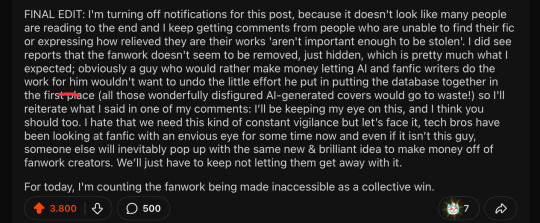
Please feel free to add info in the comments, make your own posts, take whatever action you want to take to protect your work. I only beg you—seriously, I’m on my knees here—to not give up like I saw a handful of people express the urge to do. Keep sharing your creative work and remain vigilant and stay active to make sure we can continue to do so freely. Visit your favorite fics, and the ones you’ve kept in your ‘marked for later’ lists but never made time to read, and leave kudos, leave comments, support your fandom creatives, celebrate podficcers and support AO3. We created this place and it’s our responsibility to keep it alive and thriving for as long as we possibly can.
Also FUCK generative AI. It has NO place in fandom spaces.
THE 'SMALL' PRINT (some of it in all caps):
*Weitzman knew what he was doing and can NOT claim ignorance. One, it’s pretty basic kindergarten stuff that you don’t steal some other kid’s art project and present it as your own only to act surprised when they protest and then tell the victim that they should have told you sooner that they didn’t want their project stolen. And two, he was very careful never to list the IPs these fanworks were based on, so it’s clear he was at least familiar enough with the legalities to not get himself in hot water with corporate lawyers. Fucking over fans, though, he figured he could get away with that.
**A note about the AI that Weitzman used to steal our work: it’s even greasier than it looks at first glance. It’s not just the method he used to lift works off AO3 and then regurgitate onto his own website and app. Looking beyond the untold horrors of his AI-generated cover ‘art’, in many cases these covers attempt to depict something from the fics in question that can’t be gleaned from their summaries alone. In addition, my fics (and I assume the others, as well) were listed with generated genres; tags that did not appear anywhere in or on my fic on AO3 and were sometimes scarily accurate and sometimes way off the mark. I remember You & Me & Holiday Wine had ‘found family’ (100% correct, but not tagged by me as such) and I believe The Shape of Soup was listed as, among others, ‘enemies to friends to lovers’ and ‘love triangle’ (both wildly inaccurate). Even worse, not all the fic listed (as authors on Reddit pointed out) came with their original summaries at all. Often the entire summary was AI-generated. All of these things make it very clear that it was an all-encompassing scrape—not only were our fics stolen, they were also fed word-for-word into the AI Weitzman used and then analyzed to suit Weitzman’s needs. This means our work was literally fed to this AI to basically do with whatever its other users want, including (one assumes) text generation.
***Fan fiction appears to have been made (largely) inaccessible on word-stream at this time, but I’m hearing from several authors that their original, independently published work, which is listed at places like Kindle Unlimited, DOES still appear in word-stream’s search engine. This obviously hurts writers, especially independent ones, who depend on these works for income and, as a rule, don’t have a huge budget or a legal team with oceans of time to fight these battles for them. If you consider yourself an author in the broader sense, beyond merely existing online as a fandom author, beyond concerns that your own work is immediately at risk, DO NOT STOP MAKING NOISE ABOUT THIS.
Again, please, please PLEASE reblog this post instead of the one I sent originally. All the information is here, and it's driving me nuts to see the old ones are still passed around, sending people on wild goose chases.
Thank you all so much.
47K notes
·
View notes
Text
'ao3 needs a like and dislike button'
what you need, my algorithm-rotten minded friend, is a grip
#ao3#why are people so desperate to me negative#like why do you wanna hurt strangers online#just...#don't like don't read#don't like don't interact#so simple and easy and no spreading negativity
114K notes
·
View notes
Text

2K notes
·
View notes
Text

He realized his dogs have an unusual skill. Now he uses them to help save turtles.
By Cathy Free
John Rucker was a high school English teacher in North Carolina when he stumbled upon something interesting: Whenever he took his two dogs hiking, they would run into the tall grass and bring him back box turtles. Like a gift, his Boykin spaniels would gently lay them at his feet, unharmed.
He mentioned it to a few people, and soon, biology teachers from the University of North Carolina started reaching out to him and asking whether he would take their students out so they could put transmitters on the turtles to study them.
Several years later, the outings were so successful, Rucker was fielding calls from wildlife veterinarians and zoologists who were studying turtle populations.
“Because turtles aren’t easily detected in the wild by the human eye, I could see that I was on to something,” said Rucker, now 73.
Now, two decades later, Rucker’s spaniels are a highly in-demand, specialized team trained to sniff out box turtles by following their urine trails.
The dogs — Yogi, Ruger, Jenny Wren, Lazarus, Scamp, Skeeter and Rooster — travel across the country with Rucker helping to track turtle populations and identify threats and diseases.


#science#omg they way they gently hold them omg#wildlife#conservation#wildlife conservation#pets#dogs
46K notes
·
View notes
Text


Above image is a pride flag with every color band represented by a NASA image. White is Earth clouds, pink is aurora, blue is the Sun in a specific wavelength, brown is Jupiter clouds, black is the Hubble deep field, red is the top of sprites, orange is a Mars crater, yellow is the surface of Io, green is a lake with algae, blue is Neptune, and purple is the Crab Nebula in a specific wavelength.
159K notes
·
View notes
Text
I desperately wish people would start actually reading the AO3's TOS before confidently making 'user guides' to the AO3 that are just blatantly, flatly wrong.
Yes the AO3 has banned content. They do not allow anything that's illegal under US law - though US law, importantly, does not ban fictional depictions of things - and they do not allow any commercial content. That includes your ko-fi link, or mentions that you do fic commissions. If you do post fic commissions to AO3 and want to mention the commissioner, the fic is a 'request' from the commissioner. This protects the AO3 and you from copyright law.
No the AO3 is not 'a creative fanfiction archive'. It is a fandom archive. Your meta, insights, and theories are absolutely welcome and encouraged there. AO3 also encourages you to post other types of fanworks, like fan videos, podfics, and art, but unfortunately isn't able to natively host those like it does text, so fic has kind of become what it's known for. That absolutely does not mean that other types of fanwork aren't allowed, or are discouraged by the site culture! Anybody who tells you otherwise is just plain wrong!
42K notes
·
View notes
Text

dancing
3K notes
·
View notes
Text
I love how making of Sense8 is actually much simpler than I thought.

#sense8#like the cinematography needs to be STUDIED its so unique & good#another amazing show lost before its time
257K notes
·
View notes


